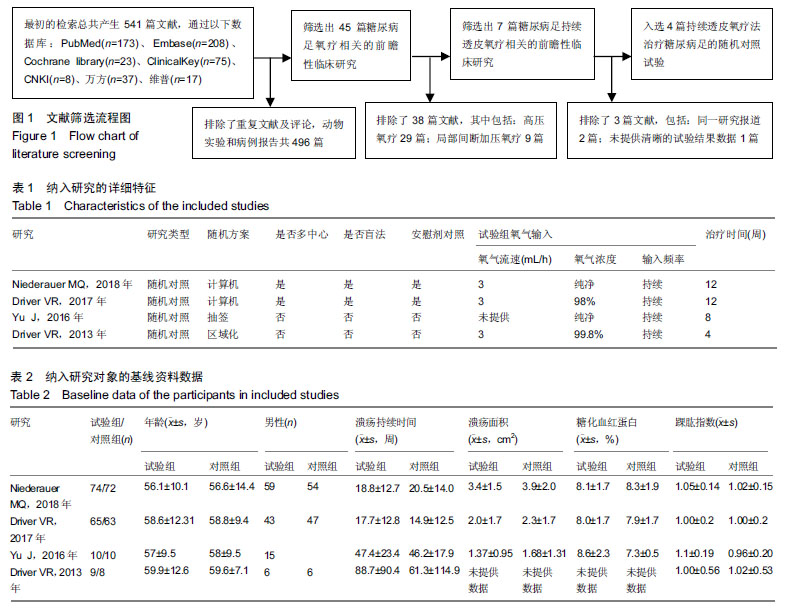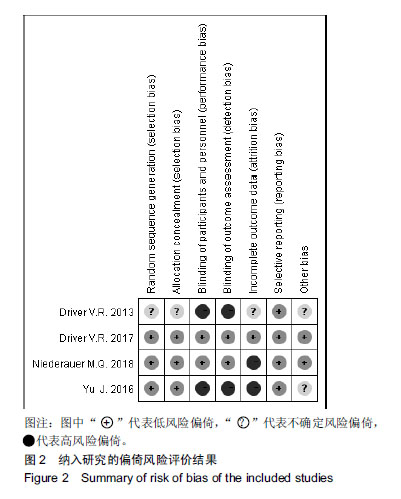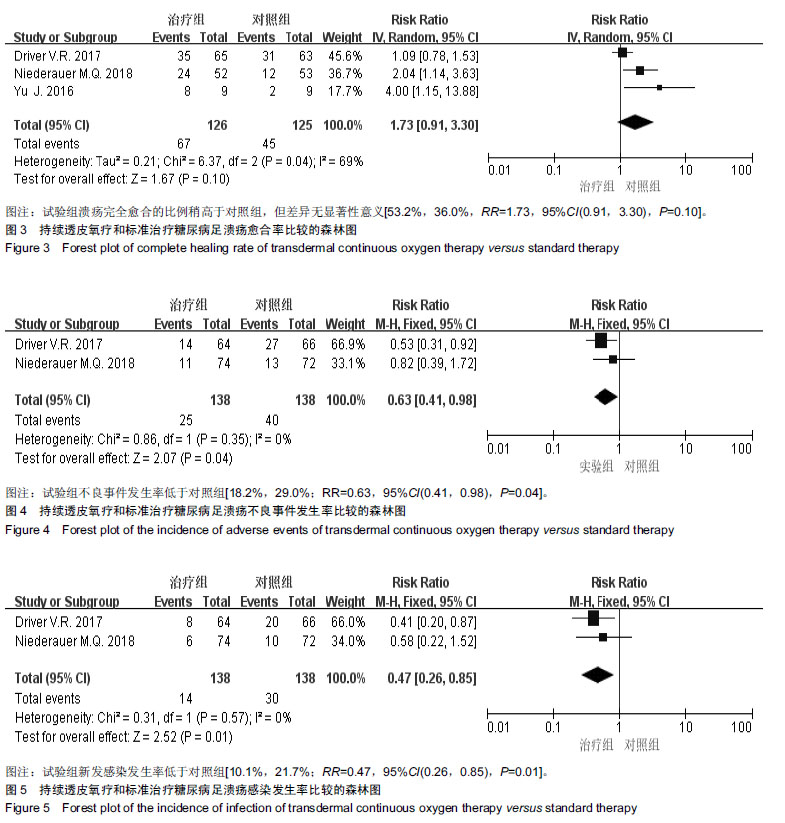| [1]Lipsky BA,Berendt AR,Cornia PB,et al.2012 Infectious Diseases Society of America clinical practice guideline for the diagnosis and treatment of diabetic foot infections.Clin Infect Dis. 2012;54(12):e132-173.[2]Cavanagh PR,Bus SA.Off-loading the diabetic foot for ulcer prevention and healing. Plast Reconstr Surg.2011;127 Suppl 1:248S-256S.[3]Cavanagh PR,Lipsky BA,Bradbury AW,et al.Treatment for diabetic foot ulcers.Lancet.2005; 366(9498):1725-1735.[4]Lipsky BA,Berendt AR,Deery HG,et al.Diagnosis and treatment of diabetic foot infections.Plast Reconstr Surg. 2006;117(7 Suppl):212S-238S.[5]Asmis R,Qiao M,Zhao Q.Low flow oxygenation of full‐excisional skin wounds on diabetic mice improves wound healing by accelerating wound closure and reepithelialization.Int Wound J 2010;7(5):349-357.[6]Woo KY,Coutts PM,Sibbald RG.Continuous topical oxygen for the treatment of chronic wounds: a pilot study.Adv Skin Wound Care.2012;25(12):543-754.[7]Urrea-Botero G.Can continuous diffusion of oxygen heal chronic toe ulcers?Podiatry Today.2015; 28(10):1-7.[8]Brannick B,Engelthaler M,Jadzak J,et al.A closer look at continuous diffusion of oxygen therapy for a chronic, painful venous leg ulcer.Podiatry Today.2014;27(11).[9]Driver VR,Reyzelman A,Kawalec J,et al.A Prospective, Randomized, Blinded, Controlled Trial Comparing Transdermal Continuous Oxygen Delivery to Moist Wound Therapy for the Treatment of Diabetic Foot Ulcers. Ostomy Wound Manage.2017;63(4):12-28.[10]American Diabetes Association.Foot care in patients with diabetes mellitus(Position Statement).Diabetes Care.1996; 19(Suppl.1):S23-S24.[11]The Cochrane Collaboration. Cochrane handbook for systematic reviews of interventions. Available at: http://www.cochrane.org/.[12]Niederauer MQ,Michalek JE,Liu Q,et al.Continuous diffusion of oxygen improves diabetic foot ulcer healing when compared with a placebo control: a randomised, double-blind, multicentre study. J Wound Care.2018;27(Sup9):S30-S45.[13]Driver VR,Yao M,Kantarci A,et al.A prospective, randomized clinical study evaluating the effect of transdermal continuous oxygen therapy on biological processes and foot ulcer healing in persons with diabetes mellitus.Ostomy Wound Manage. 2013;59(11):19-26.[14]Yu J,Lu S,McLaren AM,et al.Topical oxygen therapy results in complete wound healing in diabetic foot ulcers.Wound Repair Regen.2016;24(6):1066-1072.[15]Pandit AS,Feldman DS.Effect of oxygen treatment and dressing oxygen permeability on wound healing.Wound Repair Regen.1994;2(2):130-137.[16]Niinikoski J. Effect of oxygen supply on wound healing and formation of experimental granulation tissue. Acta Physiol Scand Suppl.1969;334:1-72.[17]Stephens FO,Hunt TK.Effect of changes in inspired oxygen and carbon dioxide tensions on wound tensile strength: an experimental study.Ann Surg.1971;173(4):515-519.[18]Knighton DR,Silver IA,Hunt TK.Regulation of wound-healing angiogenesis-effect of oxygen gradients and inspired oxygen concentration.Surgery.1981;90(2):262-270.[19]Wattel F,Mathieu D.[Oxygen and wound healing].Bull Acad Natl Med.2005;189(5):853-864.[20]Sen CK.The general case for redox control of wound repair. Wound Repair Regen. 2003;11(6):431-438.[21]Roy S,Khanna S,Sen CK.Redox regulation of the VEGF signaling path and tissue vascularization: Hydrogen peroxide, the common link between physical exercise and cutaneous wound healing. Free Radic Biol Med.2008;44(2):180-192.[22]Demidova-Rice TN,Hamblin MR,Herman IM.Acute and impaired wound healing: pathophysiology and current methods for drug delivery, part 1: normal and chronic wounds: biology, causes, and approaches to care. Adv Skin Wound Care.2012;25(7):304-314.[23]Barrientos S,Stojadinovic O,Golinko MS,et al.Growth factors and cytokines in wound healing. Wound Repair Regen.2008; 16(5):585-601.[24]Schreml S,Szeimies RM,Prantl L,et al.Oxygen in acute and chronic wound healing. Br J Dermatol. 2010;163(2):257-268.[25]Gordillo GM,Sen CK.Revisiting the essential role of oxygen in wound healing.Am J Surg. 2003;186(3):259-263.[26]Sen CK.Wound healing essentials: let there be oxygen. Wound Repair Regen.2009;17(1):1-18.[27]Eisenbud DE.Oxygen in wound healing: nutrient, antibiotic, signaling molecule, and therapeutic agent.Clin Plast Surg. 2012;39(3):293-310.[28]Bishop A.Role of oxygen in wound healing.J Wound Care. 2008;17(9):399-402.[29]Ennis WJ,Foremann P,Mozen N,et al.Ultrasound therapy for recalcitrant diabetic foot ulcers: results of a randomized, double-blind, controlled, multicenter study.Ostomy Wound Manage. 2005;51(8):24-39.[30]Davis JC,Hunt TK,Kelman Cohen I.Problem wounds:the role of oxygen.Elsevier Publishing Company,1989.[31]靳红绪,黄立宁,王忠义,等.加速康复外科策略对腹腔镜结直肠癌手术患者术后恢复的影响[J].临床麻醉学杂志, 2016,32(12): 1149-1153.[32]Stoppe C,Grieb G,Rossaint R,et al.High postoperative blood levels of macrophage migration inhibitory factor are associated with less organ dysfunction in patients after cardiac surgery.Mol Med. 2012;18:843-850.[33]Cronjé FJ.Oxygen therapy and wound healing--topical oxygen is not hyperbaric oxygen therapy.S Afr Med J. 2005; 95(11):840. |
.jpg) 文题释义:
持续透皮氧疗法:该方法不同于高压氧疗和局部加压氧疗法,是指以纯净的(一般浓度为98%-100%)极低流量的氧气(3 mL/h)连续输送到伤口部位,不间断的进行治疗,其优点为设备的易用性、治疗的非侵入性且无痛。
糖尿病足溃疡:为在踝关节水平以下延伸累及全层皮肤的伤口,是糖尿病的常见、难治性并发症,其目前的标准疗法包括控制血糖水平、控制感染、减轻足部压力等,但治疗效果较差,即使采用综合治疗方案,糖尿病足溃疡12-20周的治愈率仅为24%-30%,并且可能会发生骨髓炎、蜂窝织炎、截肢等严重并发症。
文题释义:
持续透皮氧疗法:该方法不同于高压氧疗和局部加压氧疗法,是指以纯净的(一般浓度为98%-100%)极低流量的氧气(3 mL/h)连续输送到伤口部位,不间断的进行治疗,其优点为设备的易用性、治疗的非侵入性且无痛。
糖尿病足溃疡:为在踝关节水平以下延伸累及全层皮肤的伤口,是糖尿病的常见、难治性并发症,其目前的标准疗法包括控制血糖水平、控制感染、减轻足部压力等,但治疗效果较差,即使采用综合治疗方案,糖尿病足溃疡12-20周的治愈率仅为24%-30%,并且可能会发生骨髓炎、蜂窝织炎、截肢等严重并发症。.jpg) 文题释义:
持续透皮氧疗法:该方法不同于高压氧疗和局部加压氧疗法,是指以纯净的(一般浓度为98%-100%)极低流量的氧气(3 mL/h)连续输送到伤口部位,不间断的进行治疗,其优点为设备的易用性、治疗的非侵入性且无痛。
糖尿病足溃疡:为在踝关节水平以下延伸累及全层皮肤的伤口,是糖尿病的常见、难治性并发症,其目前的标准疗法包括控制血糖水平、控制感染、减轻足部压力等,但治疗效果较差,即使采用综合治疗方案,糖尿病足溃疡12-20周的治愈率仅为24%-30%,并且可能会发生骨髓炎、蜂窝织炎、截肢等严重并发症。
文题释义:
持续透皮氧疗法:该方法不同于高压氧疗和局部加压氧疗法,是指以纯净的(一般浓度为98%-100%)极低流量的氧气(3 mL/h)连续输送到伤口部位,不间断的进行治疗,其优点为设备的易用性、治疗的非侵入性且无痛。
糖尿病足溃疡:为在踝关节水平以下延伸累及全层皮肤的伤口,是糖尿病的常见、难治性并发症,其目前的标准疗法包括控制血糖水平、控制感染、减轻足部压力等,但治疗效果较差,即使采用综合治疗方案,糖尿病足溃疡12-20周的治愈率仅为24%-30%,并且可能会发生骨髓炎、蜂窝织炎、截肢等严重并发症。


.jpg) 文题释义:
持续透皮氧疗法:该方法不同于高压氧疗和局部加压氧疗法,是指以纯净的(一般浓度为98%-100%)极低流量的氧气(3 mL/h)连续输送到伤口部位,不间断的进行治疗,其优点为设备的易用性、治疗的非侵入性且无痛。
糖尿病足溃疡:为在踝关节水平以下延伸累及全层皮肤的伤口,是糖尿病的常见、难治性并发症,其目前的标准疗法包括控制血糖水平、控制感染、减轻足部压力等,但治疗效果较差,即使采用综合治疗方案,糖尿病足溃疡12-20周的治愈率仅为24%-30%,并且可能会发生骨髓炎、蜂窝织炎、截肢等严重并发症。
文题释义:
持续透皮氧疗法:该方法不同于高压氧疗和局部加压氧疗法,是指以纯净的(一般浓度为98%-100%)极低流量的氧气(3 mL/h)连续输送到伤口部位,不间断的进行治疗,其优点为设备的易用性、治疗的非侵入性且无痛。
糖尿病足溃疡:为在踝关节水平以下延伸累及全层皮肤的伤口,是糖尿病的常见、难治性并发症,其目前的标准疗法包括控制血糖水平、控制感染、减轻足部压力等,但治疗效果较差,即使采用综合治疗方案,糖尿病足溃疡12-20周的治愈率仅为24%-30%,并且可能会发生骨髓炎、蜂窝织炎、截肢等严重并发症。